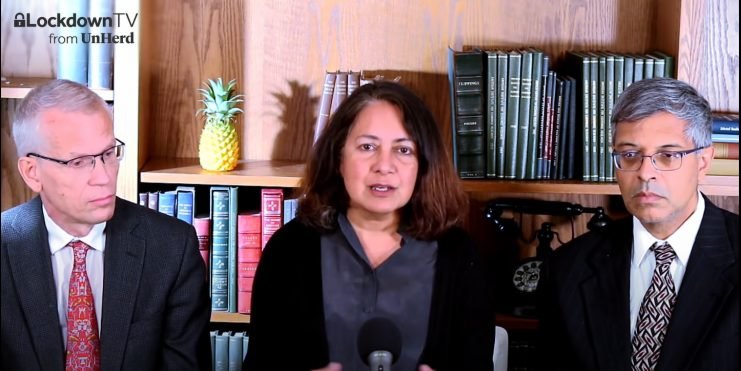Advertisment
New covid strategy proposed

Article written by Christine Clark
Leading scientists propose a ‘more humane’ strategy for the management of the coronavirus pandemic.
A blueprint for a kinder and more effective strategy to manage the coronavirus pandemic has been published by a team of three scientists – Dr Martin Kulldorff, professor of medicine at Harvard University, Dr Sunetra Gupta, professor of theoretical epidemiology at Oxford University and Dr Jay Bhattacharya, professor at Stanford University Medical School – with the support of a further 35 leading scientists worldwide. (See the Great Barrington Declaration )
Current strategies are not effective. In the UK the policy is to ‘control the virus’ through lockdowns and related measures whilst waiting for the arrival of an effective vaccine. They can only prolong the circulation of the virus rather than eliminate it. In the meantime, they result in extensive collateral damage including delays to cancer diagnoses and treatment, falling vaccination rates and mental health problems. Because they are unselective – and lock down both those at minimal risk and those at high risk – the burden falls disproportionately on the underprivileged. Lockdown can be weathered by those with financial buffers but many do not have these. In addition, lock-downs strangle commerce and lead to the collapse of businesses. These are all significant consequences – and part of the price for the current strategy.
The Great Barrington Declaration proposes an alternative approach bearing in mind that a strategy must take into account the totality of public health and not focus on one element without considering the wider consequences. Current strategies for covid management have failed to do this and have generated enormous collateral damage, says Professor Kulldorff. In a video interview, the authors of the declaration explain their thinking in more detail.
The authors point out that we know great deal more about the virus than we did in March and they have formulated their proposal with this new knowledge in mind. The virus has one great weakness – its differential effects on the young and old. There is a 1000-fold difference in the risk of mortality between the youngest and oldest individuals – and this is something that we should be exploiting, argues Professor Kulldorff. The proposed strategy, in essence, is to protect (or shield) the vulnerable but allow the young to go about their daily lives unhindered – going to work, to school, to sports venues and to restaurants. Creative use of social security systems could ensure that this is done without undue hardship. Young people would contract the infection but be largely unaffected and it could reasonably be expected that the epidemic would peak and resolve in the space of three months, explains Professor Gupta. After this time there should be a sufficient level of herd immunity to ensure that older and vulnerable people could safely be released from lockdown/isolation. They would be protected because the virus would no longer be circulating.
Herd immunity
People often mistakenly associate herd immunity with a ‘do nothing’ approach but this is a serious misrepresentation. “Herd immunity is not a strategy, it is a biological fact”, argues Professor Bhattacharya. Moreover, vaccination relies on herd immunity for its effectiveness as a means of controlling infectious disease.
“We will be relying on a combination of vaccine-generated immunity and naturally-acquired immunity to provide the level of protection that we need in future”, says Professor Gupta.
Whatever strategy is used the endpoint is herd immunity. If the ‘do nothing’ approach is followed, some old and some young people are infected and there are many deaths. If everyone is protected (i.e. lockdown for all) the result is much the same but it takes longer. If a targeted strategy is adopted that protects the elderly and vulnerable, then more young people than old will be infected and there will be fewer deaths than with the alternative approaches. Such a strategy could involve using only staff who have already had the infection (i.e. have immunity) in nursing homes and/or carry out frequent testing of staff and visitors, suggests Professor Kulldorff. Older people in the workforce should work from home. “If we want to minimise deaths in the long term an age-targeted strategy would be appropriate both for its impact on covd19 and on collateral damage”, he says.
“At present we are protecting low-risk college students and professionals but older working class people have to work because they are bus drivers or supermarket workers. So, we are protecting low-risk people in a privileged class while putting the burden of generating immunity – that will eventually protect all of us – on the working class, especially the urban working class”, says Professor Kulldorff.
Focused or targeted protection of the type advocated would actually shorten the period of ‘isolation separation’ (when the vulnerable have to be separated from low-risk individuals) compared with current policy. The scientists envisage that the separation would only need to continue until young people no longer pose a threat to the vulnerable and elderly.
The proposed approach both reduces harm (from disease) to the vulnerable and reduces (economic and social) harm to those at little risk from the disease. It goes hand in hand with accurate public health messaging about levels of risk.
In many ways the proposed strategy is a basic, traditional public health approach. In this case the science and the morality point in the same direction, as does standard public health practice.
CMC 08.10.20





